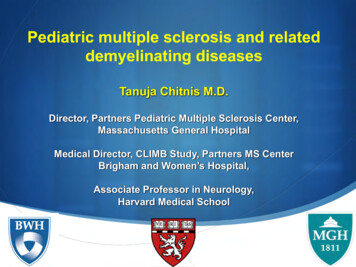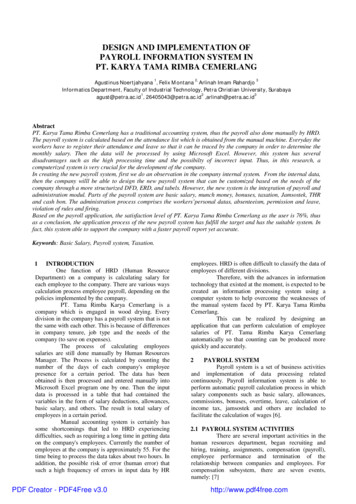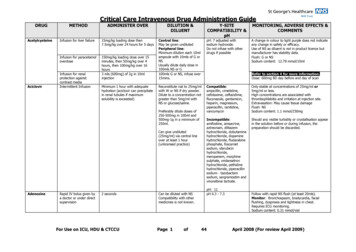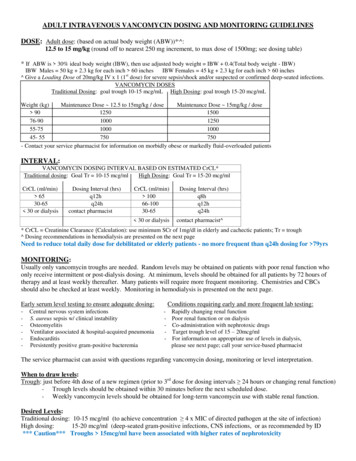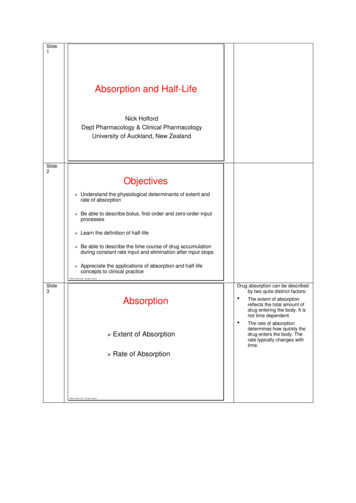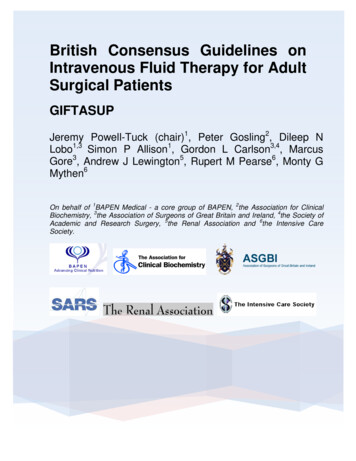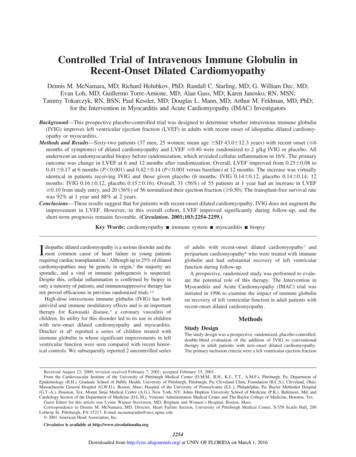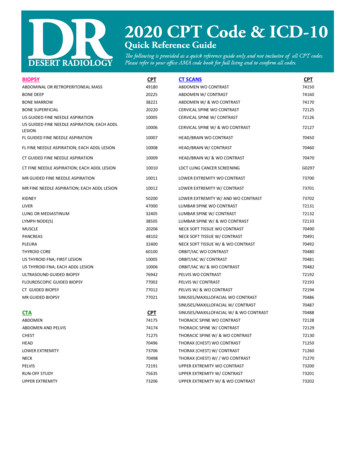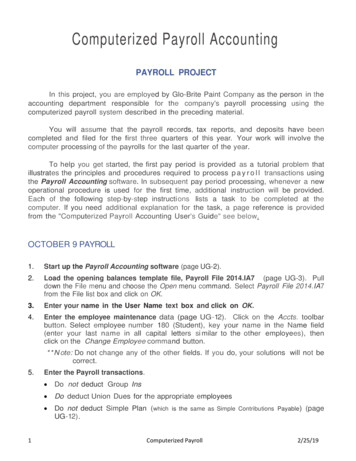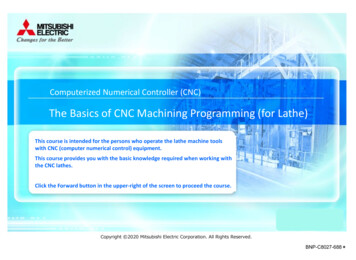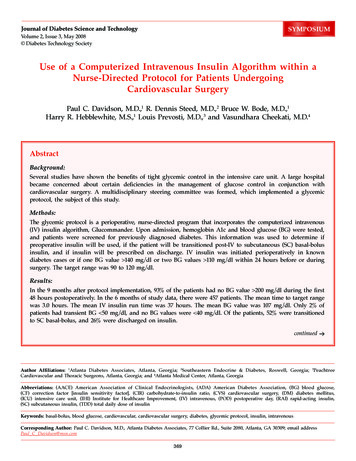
Transcription
Journal of Diabetes Science and TechnologySYMPOSIUMVolume 2, Issue 3, May 2008 Diabetes Technology SocietyUse of a Computerized Intravenous Insulin Algorithm within aNurse-Directed Protocol for Patients UndergoingCardiovascular SurgeryPaul C. Davidson, M.D.,1 R. Dennis Steed, M.D.,2 Bruce W. Bode, M.D.,1Harry R. Hebblewhite, M.S.,1 Louis Prevosti, M.D.,3 and Vasundhara Cheekati, M.D.4AbstractBackground:Several studies have shown the benefits of tight glycemic control in the intensive care unit. A large hospitalbecame concerned about certain deficiencies in the management of glucose control in conjunction withcardiovascular surgery. A multidisciplinary steering committee was formed, which implemented a glycemicprotocol, the subject of this study.Methods:The glycemic protocol is a perioperative, nurse-directed program that incorporates the computerized intravenous(IV) insulin algorithm, Glucommander. Upon admission, hemoglobin A1c and blood glucose (BG) were tested,and patients were screened for previously diagnosed diabetes. This information was used to determine ifpreoperative insulin will be used, if the patient will be transitioned post-IV to subcutaneous (SC) basal-bolusinsulin, and if insulin will be prescribed on discharge. IV insulin was initiated perioperatively in knowndiabetes cases or if one BG value 140 mg/dl or two BG values 110 mg/dl within 24 hours before or duringsurgery. The target range was 90 to 120 mg/dl.Results:In the 9 months after protocol implementation, 93% of the patients had no BG value 200 mg/dl during the first48 hours postoperatively. In the 6 months of study data, there were 457 patients. The mean time to target rangewas 3.0 hours. The mean IV insulin run time was 37 hours. The mean BG value was 107 mg/dl. Only 2% ofpatients had transient BG 50 mg/dl, and no BG values were 40 mg/dl. Of the patients, 52% were transitionedto SC basal-bolus, and 26% were discharged on insulin.continuedAuthor Affiliations: 1Atlanta Diabetes Associates, Atlanta, Georgia; 2Southeastern Endocrine & Diabetes, Roswell, Georgia; 3PeachtreeCardiovascular and Thoracic Surgeons, Atlanta, Georgia; and 4Atlanta Medical Center, Atlanta, GeorgiaAbbreviations: (AACE) American Association of Clinical Endocrinologists, (ADA) American Diabetes Association, (BG) blood glucose,(CF) correction factor [insulin sensitivity factor], (CIR) carbohydrate-to-insulin ratio, (CVS) cardiovascular surgery, (DM) diabetes mellitus,(ICU) intensive care unit, (IHI) Institute for Healthcare Improvement, (IV) intravenous, (POD) postoperative day, (RAI) rapid-acting insulin,(SC) subcutaneous insulin, (TDD) total daily dose of insulinKeywords: basal-bolus, blood glucose, cardiovascular, cardiovascular surgery, diabetes, glycemic protocol, insulin, intravenousCorresponding Author: Paul C. Davidson, M.D., Atlanta Diabetes Associates, 77 Collier Rd., Suite 2080, Atlanta, GA 30309; email addressPaul C Davidson@msn.com369
Use of a Computerized Intravenous Insulin Algorithm within a Nurse-Directed Protocol for Patients Undergoing Cardiovascular SurgeryDavidsonAbstract cont.Conclusions:The Glucommander earned high respect from the nurses for the way it scheduled BG tests and eliminatedthe calculation time and calculation errors associated with manual methods. The protocol was highly effectivein normalizing glucose without hypoglycemia. The multidisciplinary steering committee proved to be a goodapproach to implementing a glycemic protocol.J Diabetes Sci Technol 2008;2(3):369-375IntroductionNIn August 2005, prior to the institution of these guidelinesat Piedmont Hospital in Atlanta, Georgia, postcoronarybypass patients received IV boluses of sliding scaleinsulin, there were rare endocrine consults, and thepatients were in generally poor glucose control. One ofthe authors (P.C.D.), an endocrinologist on staff, wrote areport detailing the poor glycemic control in a postbypass type 1 patient with diabetes and offered aworking protocol recommending a more aggressivediabetes management plan based on a computerizedalgorithm. At the time of this appeal, Piedmont Hospitalhad already joined the 100,000 Lives Campaign ofInstitute for Healthcare Improvement (IHI).6 An analysisof the preceding 5 months revealed that only 54% ofthe cardiovascular (CV) patients had met the IHIinitiative of all blood glucose values being 200 mg/dlin the first 48 hours postsurgery. Within days aftercirculating the report, the cardiothoracic surgeons andICU administration agreed to work toward a solution.The administration sanctioned the formation of a steeringcommittee and agreed to support it.umerous studies to date have shown the benefitsand also the risks of tight glycemic control in thehospital, specifically in the intensive care unit (ICU).1–3Tight control usually requires complex insulin dosingregimens that are restricted to the ICU due to the needfor a skilled, highly trained staff of nurses who areresponsible for only one or two patients at a time. Severehypoglycemia is a concern with many intravenous (IV)insulin protocols and, in at least one study, has beenshown to be an independent risk factor for mortality.4This article discusses the methods, results, and benefitsof a nurse-directed, computerized protocol in patientsundergoing coronary bypass or valve surgery.The recommended goals for glycemic control in thehospital vary slightly. In the ICU, both the AmericanAssociation of Clinical Endocrinologists (AACE) andthe American Diabetes Association (ADA)5 recommend 110 mg/dl; in the general medical–surgical units, AACErecommends 110 mg/dl premeal and peak postprandial 180 mg/dl, whereas ADA recommends 90 to 130 mg/dlpremeal. According to ACE/ADA guidelines,5 componentsof the optimum strategy for achieving improvedmanagement of diabetes in hospitalized patients consistof the following.The Piedmont Steering Committee was multidisciplinary,composed of persons from thoracic surgery, endocrinology,nursing (ICU and step-down), pharmacy, the diabetestreatment center, nutrition, and the heart center. Thefocus was limited to cardiothoracic surgery only. It wasrecognized that the burden of carrying out the protocolwould fall on nurses.1. An appropriate level of administrative support2. Formation of a multidisciplinary steering committeeto promote the development of initiatives3. Assessment of current processes, quality of care, andbarriers to necessary changes in practiceMethodology4. Development and implementation of interventions,including standardized order sets, protocols, policies,and algorithms, with associated educational programs5. Metrics for evaluationJ Diabetes Sci Technol Vol 2, Issue 3, May 2008370Based on the aforementioned goals, the Piedmont SteeringCommittee decided to implement a nurse-directed tightglycemic control protocol for patients undergoing coronarybypass and valve surgery. In order to accomplish thistask, the committee met weekly over a 5-month periodwww.journalofdst.org
DavidsonUse of a Computerized Intravenous Insulin Algorithm within a Nurse-Directed Protocol for Patients Undergoing Cardiovascular Surgeryto develop such a protocol. A protocol was agreed upon andinitiated in February 2006. Since then all cardiovascularsurgery (CVS) patients have been included. The specificsof the protocol are as follows.Glycemic Protocol1. The protocol is nurse-directed so that all patients aretreated uniformly.2. For all patients, hemoglobin A1c and glucose aretested on arrival. Hemoglobin A1c is used to guidepost-IV therapy, including the duration of IV insulin,the need for SC after IV insulin, and the need forinsulin therapy upon discharge.3. If a patient is admitted on the day before surgeryand the hemoglobin A1c is 6%, or if the premealBG is 140 mg/dl, or if the patient is known to havediabetes, then a weight-based basal-bolus SC insulinregimen is initiated, followed by IV insulin overnightpreoperatively.Subcutaneous basal-bolus treatment, pre-IV. For total dailydose of insulin (TDD), a weight-based formula is usedpreoperatively and prior to the Glucommander: weightin kilogram 0.5 TDD. Fifty percent of this is basal,given as glargine at bedtime. The remaining 50% ofTDD is given as three premeal doses of rapid-actinginsulin (RAI), resulting in one-sixth of TDD for eachmeal. Bedside capillary glucose (BG) is tested premeal, atbedtime, and at 0300, with a correction dose of RAI givenfor a BG value 140 mg/dl. The correction formula is(BG – 100) divided by the correction factor. The correctionfactor (CF) is determined by the 1700 rule (1700 dividedby the known or estimated TDD).94. Intravenous insulin delivery using the Glucommanderis initiated as described earlier for anyone with oneBG value 140 mg/dl or two BG values 110 mg/dlwithin 24 hours before or during surgery. Targetsfor glucose control are 90 to 120 mg/dl. All glucosevalues in the ICU are monitored from arterial bloodusing Abbott meters.Subcutaneous basal-bolus treatment, post-IV. The method fortransition from the Glucommander to basal-bolus insulintherapy in this protocol is applied to all patients withknown diabetes or hemoglobin A1c 6%. Formulae forthe transition are predicated on BGref 60 mg/dl anda concurrent IV drip of 10% glucose at 50 cc/hr. Thetransition is made (at 9 pm) if the patient’s BG has beenin the target range for three consecutive BG tests and ifthe multiplier has been stable for three consecutive BGtests. The multiplier is used for the transition calculationsas follows:5. Hypoglycemia ( 60 mg/dl) is treated only with IV 50%dextrose based on a formula that is calculated to notovershoot the target range of 90 to 120 mg/dl.76. The IV insulin therapy is continued until the morningof postoperative day (POD) #1 if hemoglobin A1c 6%and to POD #2 in persons with known diabetes orhemoglobin A1c 6%.7. Post-ICU transition to SC insulin is conducted for allpatients with preexisting diabetes or hemoglobin A1c 6%.The SC dosing is based on the patient’s IV insulinrequirement. The glargine basal insulin is started atabout 9:00 p.m. the night before IV insulin is stopped. Basal Insulin (glargine):Multiplier * 500 Correction Bolus (aspart):(BG – 100) * Multiplier/1.78. Endocrine consultation is obtained for any patientwith a BG value 70 or 140 mg/dl or for any patienton basal-bolus insulin. Meal Bolus (aspart):Multiplier * 1679. Discharge planning with diabetes education isinitiated for all patients with hemoglobin A1c 7%.Patients with hemoglobin A1c 7% are discharged onpreadmission therapy.J Diabetes Sci Technol Vol 2, Issue 3, May 2008Intravenous phase. The Glucommander is a computerguided insulin infusion system invented by Davidson andSteed in 1984.8 Insulin is administered by the followingformula: insulin units/hour multiplier (BG – BGref).BGref is a reference value, set at 60 mg/dl. The multiplieris adjusted by the computerized algorithm if the bloodglucose is not approaching the target range (e.g., 90 to120 mg/dl), which is input by the nurse at the start of theGlucommander, independently of BGref. There is a variabletime interval between blood glucose checks, based onstability of the glucose level. An alarm reminds thenurses when to recheck the glucose level and enter itinto the Glucommander, which calculates a new insulininfusion rate and stores data. Carbohydrate-to-Insulin Ratio (CIR) (aspart):0.45/Multiplier371www.journalofdst.org
DavidsonUse of a Computerized Intravenous Insulin Algorithm within a Nurse-Directed Protocol for Patients Undergoing Cardiovascular SurgeryResultsThe transition is initiated by the nurse. Posttransition, aconsulting endocrinologist monitors and confirms eachpatient’s insulin dosing. SC insulin doses are adjustedby 20% if BG readings are outside the 70- to 140-mg/dlrange. The diet is initially an 1800-kcal ADA diet in allpatients, with subsequent adjustment based on nutritionalconsultation.As of December 2007, over 1800 patients have been treatedby this protocol with no exceptions. Detailed data werecollected for the first 457 patients, who were analyzed inthis retrospective study. Results are as follows.Data CollectionIntravenous phase, Glucommander. The program is installedin a Palm device at each patient’s bedside. In the processof operation, the Glucommander records time, BG,multiplier, and IV insulin infusion rate. This informationis available by downloading. Immediately after downloading from the Palm device and inserting in thepatient’s medical record, personal identifying informationwas removed from data.Subcutaneous phase. The manual BG meter automaticallydownloads to the hospital mainframe computer whenplaced in the charging stand, making time-logged BGvalues available from the computer. Administration ofSC insulin and doctor’s orders are also available fromthe computer. Immediately after downloading from thehospital mainframe for placing into the study’s database,all personal identifying data were deleted.Table 1.Description of Sample of Patients at Admission andStage by Stage through Hospital Stay to DischargePatients at admissionAverage age63 11Average weight (kg)88 26Average body mass index30 8SexMale70%Female30%At admissionReassurances that Health Insurance Portability andAccountability Act violations did not occur. All interactionsand data collection were done by one of the authors(P.C.D.) as a requisitioned medical consultation. Noinstitutional review board approval was indicated. Allidentifiers of individual patients were stripped fromthe records prior to analysis. Permission to includepatients in this study was not necessary, as the activitiesand collected information were part of routine qualitymedical care.% on insulin10% with previously diagnosed DM28% with hemoglobin A1c 648% with any of the above52Patients admitted on OHA a21%OHA types (% of patients on OHA)Statistical MethodsOur study was compared to Piedmont’s preprotocolcalendar period as follows: From the hospital’s mainframecomputer, the following data were extracted. For theperiod of 5 months prior to the protocol, counts wereobtained for patients with no BG value 200 for the first48 hours after surgery and for patients with at least oneBG value 200 for the first 48 hours after surgery. For theperiod of 9 months after implementation of the protocol,the same data were obtained. We did not remove anypersonal identifying data from the hospital’s mainframecomputer. These four groups were analyzed by a χ2 test,as they were count data.J Diabetes Sci Technol Vol 2, Issue 3, May 20081. All CVS patients were treated by the protocol. Thedescription of the sample of patients at admissionis shown in Table 1. The protocol enabled easydetermination of stage-by-stage treatment regimensduring the patients’ hospital stays and at discharge,as also shown in Table lidinediones33Decisions by protocolPercentage given postoperative IV insulin96Percentage given post-IV basal-bolus insulin52Percentage discharged on insulin26(all had been on post-IV basal-bolus;all were discharged on basal-bolus)aOral hypoglycemia agentswww.journalofdst.org
DavidsonUse of a Computerized Intravenous Insulin Algorithm within a Nurse-Directed Protocol for Patients Undergoing Cardiovascular Surgery2. On IV insulin, the mean time to 120 mg/dl was3.0 hours. IV insulin was continued for a mean of37 hours. Mean BG was 107 mg/dl, 7.7% of patientshad a BG value 60 mg/dl, 2% of patients had atransient BG value 50 mg/dl, and no patient had aBG value 40 mg/dl (see Table 2).Table 2.Blood Glucose Results for Varied BG and TimeRanges Encompassing Postoperative IV Insulin andSubcutaneous Insulina3. In the 9 months after the initiation of the protocol,93% of patients were well controlled to a degreethat no BG value was 200 mg/dl during the first48 hours postoperatively (see Figure 1). This comparesto 54% during the 5-month period before the inceptionof the protocol. The accompanying count data wereas follows: In the 5 months before the initiation ofthe protocol there were 176 patients with no BGvalue 200 mg/dl and 149 patients with at least oneBG value 200. In the 9 months after initiation of theprotocol there were 543 patients with no BG value 200 and 42 patients with at least one BG value 200mg/dl. A χ2 test gave a significant result (P 0.001).aBGsGlucommander 4 hrPost-GlucommanderN29672920Mean103 mg/dl122 mg/dlSD1940No.%BG%PtsNo.%BG%Pts 20041.314.31424.928 60100.347.7451.614 5030.12130.46 4000020.11.3Ninety-eight percent of BG values remained in the 60- to 200-mg/dlrange while on the Glucommander. For comparison with the table,the percentage of patients with any BG 40 mg/dl in the surgicalICU at the University of Leuven was 5.2%.1 Pts, patients.4. The results of glucose levels in various ranges areshown in Table 2. For comparison, the percentage ofglucoses less than 40 mg/dl in Leuven data was 5.2%.15. Figure 2 shows a graph of mean glucose level vstime achieved with the Glucommander for patientswith previously diagnosed diabetes mellitus (DM) orhemoglobin A1c 6%, before transition to SC.6. All patients with previously diagnosed DM orhemoglobin A1c 6% were transitioned to SCbasal-bolus (52% of patients). Figure 3 shows agraph of mean blood glucose vs time achieved withbasal-bolus after transition from IV.7. The average multiplier at transition was 0.045 (range0.016–0.183). From this, the average basal 0.045 * 500 22.5 units (range 8–92), the average meal bolus 0.045 * 167 7.5 units (range 3–31), the average CIR 0.45/ 0.045 10 grams of carbohydrate/unit (range 2.5–28), and the average CF 1.7/0.045 38 (range 9–106).8. In posttransitioned data, only 0.4% of the BG valueswere 50 mg/dl and only 4.9% were 200.9. Nursing acceptance is uniformly enthusiastic. Theonly initial complaint was the increased frequency ofglucose monitoring while on IV insulin. This complaintsubsided once the nurses observed the optimalcontrol and the infrequency of needing to call fororder changes. Because of Glucommander prompting,nurses were able to follow the protocol within theirfirst shift on the CV ICU postoperative unit or CVJ Diabetes Sci Technol Vol 2, Issue 3, May 2008373Figure 1. Percent of patients with all BG values 200 mg/dl for 48 hourspostsurgery. A χ2 test showed a significant (P 0.001) improvement incontrol concurrent with implementation of the glycemic protocol on adevelopmental basis, including the Glucommander, which occurred inJanuary 2006. The protocol was finalized in February 2006.floor. Surgeons’ acceptance of the protocol has beenpositive with no complaints.DiscussionIn most hospitals, transition is a vulnerable point forlosing control over intensive insulin therapy. From the11-fold variation in final multipliers reported earlier, itcan be seen that the variation in insulin sensitivity(affecting the basal insulin, CF, and CIR) is so great thatwithout some individualized index of insulin sensitivity,such as use of the Glucommander multiplier employedwww.journalofdst.org
Use of a Computerized Intravenous Insulin Algorithm within a Nurse-Directed Protocol for Patients Undergoing Cardiovascular SurgeryConclusionsherein, it would be difficult to transition patients quicklyand smoothly from IV insulin to glycemic control withbasal-bolus insulin.This nurse-directed, glycemic protocol utilizing acomputerized system for IV insulin infusion andtransition to SC basal-bolus insulin therapy was highlyeffective in normalizing glucose without significanthypoglycemia in all patients undergoing CV surgeryat Piedmont Hospital in Atlanta. Several importantfactors were involved in the success of this project.Foremost, the design and implementation of the protocolwere by a group effort of diabetes specialists, nurses,pharmacists, and educators under the guidance of a CVsurgeon, who sold the program to his fellow surgeonsand the hospital administration. Empowerment of thenurses in the design, ownership, and application of theprotocol was crucial. The use of a well-researched andproven computerized algorithm for IV insulin dosing(Glucommander) was a factor in the ease of convincingthe CV unit and the hospital to undertake this upgradeof glucose management. The appropriate setting of thetarget range of 90 to 120 mg/dl allowed all patientsto obtain a mean glucose value of 107 mg/dl with noglucose value 40 mg/dl. Nurse-directed transition fromIV to SC insulin in all patients with known diabetes ora hemoglobin A1c 6% allowed normalization of glucosewith eating during the postoperative period and untildischarge. The Glucommander protocol was initiatedimmediately on all patients so there was no delay waitingfor an endocrine consult. In order to accomplish this task,all patients on admission had to be screened for diabetesand have a hemoglobin A1c drawn to aid in knowingwhich patients needed transition from IV to SC insulinand which patients would benefit from insulin upondischarge. In addition, any patient admitted with poorlycontrolled diabetes was normalized in the hospital withinsulin and discharged with an insulin regimen thatwould keep glucoses near normal. It is felt by all teammembers that a similar glycemic protocol could also beused in normalizing glucose in all other patients in thehospital system. This is now being initiated.For non-Glucommander IV algorithms, the averageinsulin infusion rate can be used as follows: TDD 8 [sum of last three insulin infusion rates]. The authorsbelieve that transition formulae from IV to SC insulindescribed herein are the most valuable new contributionof this protocol.Last on IVFigure 2. Average and standard deviations of BG values ofGlucommander runs (calculated over time segments), representingthe 238 patients who were subsequently transitioned to SC insulin(February through July 2006).Acknowledgements:The authors thank the diabetes resources personnel, supervising nursesin the CV surgery, ICU, and general surgical floor for help in planningthe protocol, and all of the staff in each of those groups for theirenthusiastic help in applying the protocol so successfully. The authorsalso thank Jennie Mattia, R.N., of the Fuqua Heart Center at PiedmontHospital.Figure 3. Average and standard deviation of BG values followingtransition from the Glucommander to basal-bolus insulin in the form ofglargine and aspart (calculated over time segments, which are centeredon scheduled BG tests). The first point is the last Glucommander pointfor each patient.J Diabetes Sci Technol Vol 2, Issue 3, May 2008Davidson374www.journalofdst.org
Use of a Computerized Intravenous Insulin Algorithm within a Nurse-Directed Protocol for Patients Undergoing Cardiovascular SurgeryDavidsonReferences:1. Van den Berghe G, Wouters P, Weekers F, Verwaest C,Bruynincks F, Schetz M, Vlasselaers D, Ferdinande P, Lauwers P,Bouillon R. Intensive insulin therapy in the critically ill patients.N Engl J Med. 2001;345(19):1359-67.2. Furnary AP, Gao G, Grunkemeier GL, Wu Y, Zerr KJ, Bookin SO,Floten HS, Starr A. Continuous insulin infusion reduces mortalityin patients with diabetes undergoing coronary artery bypassgrafting. J Thorac Cardiovasc Surg. 2003;125(5):1007-21.3. Krinsley JS. Effect of intensive glucose management on the mortalityof critically ill adult patients. Mayo Clin Proc. 2004;79(8):992-1000.4. Krinsley JS, Grover A. Severe hypoglycemia in critically ill patients:risk factors and outcomes. Crit Care Med. 2007;35(10):2262-7.5. American College of Endocrinology and American DiabetesAssociation consensus statement on in-patient diabetes andglycemic control. Endocr Pract. 2006;12(14):458-68 and DiabetesCare. 2006;29(8):1955-62.6. Institute for Healthcare Improvement . Available from: www.IHI.org/IHI/Topics/PatientSafety/ SurgicalSiteInfections/Changes/SSI Maintain Glucose Control.htm.7. Richardson PR, Steed RD, Davidson PC. Immediate correctionof hypoglycemia without rebound using variable dosing of IVglucose. Diabetes.1999;48(Suppl 1):A120.8. Davidson PC, Steed RD, Bode BW. Glucommander, a computerdirected intravenous insulin system, shown to be safe, simple, andeffective in 120,618 h of operation. Diabetes Care. 2005;28(10):241823.9. Davidson PC, Hebblewhite HR, Bode BW Steed RD, Welch NS,Greenlee MC, Richardson PL, Johnson J. Statistically-base CSIIparameters: correction factor, CF(1700 rule), carbohydrate-to-insulinratio, CIR (2.8 rule), and basal-to-total ratio. Diabetes Technol Ther.2003;5(5):A237.J Diabetes Sci Technol Vol 2, Issue 3, May 2008375www.journalofdst.org
dose of insulin (TDD), a weight-based formula is used preoperatively and prior to the Glucommander: weight in kilogram 0.5 TDD. Fifty percent of this is basal, given as glargine at bedtime. The remaining 50% of TDD is given as three premeal doses of rapid-acting
